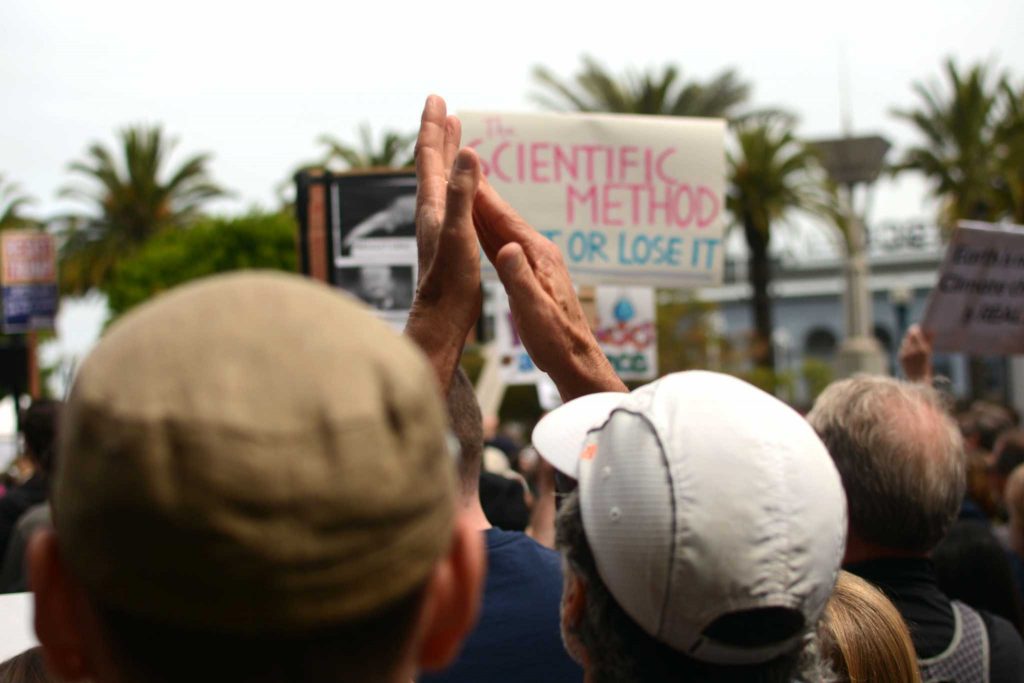Local scientists, educators and students filled Market Street for the March for Science on Earth Day to support funding, literacy and diversity in science.
The idea to organize the March for Science began in Washington D.C. in late January and spread throughout the world in more than 600 cities.
Bryan Dunyak, a San Francisco March for Science organizer, said the march was not necessarily a resistance march against the Trump administration, although some people carried “Resist Trump” signs.
Professor Dave Dempsey, earth and climate sciences department chair, said he was interested in joining the march but was hesitant to take a stance on the issue.
The goal of the march was to support science in general but indirectly focused on Trump administration’s proposal to cut support for science, according to Dempsey.

The proposal seeks to cut funding for the Sea Grant Program which supports marine research conducted at 33 universities, including SF State, according to the Washington Post.
The California Sea Grant, largely funded by the federal government, provides grants and fellowship opportunities for graduate students, including SF State students, in marine science.
“A number of our grants include graduate students on the funded proposals,” said James Eckman, program director. “So you will have students working with their masters or PhDs that are fully supported by Sea Grants programs.”
The Moss Landing Marine Laboratories offer master’s degree programs in marine sciences for seven California State Universities in northern and central California.
Jim Harvey, MLML director, said the loss of the Sea Grant will negatively impact the marine community and the seafood industry.
“There are five SFSU students that are at MLML finishing their master’s degrees in marine science,” Harvey said. “They are taking courses and conducting research using the full complements of the resources at MLML, including the support of Sea Grant funding.”
Members of the Society for Advancement of Chicanos and Native Americans in Science at SF State, which promotes the representation of minorities in science, marched to promote scientific research and diversity.

“I don’t look like a typical scientist,” said Marco Monroy, SACNAS president and SF State biology graduate student.
Monroy said he would join the march to promote scientific research and diversity, however, many students and educators from local universities got involved because of the funding cuts that will make it difficult for scientists to do research.
The potential elimination of science funding will impact not only students but also local scholars.
Suzane Hecker, a local geologist who joined the march, said the loss of federal funds will be a big issue for professional scientists that rely on federal funding for basic research, which is necessary to move on to more advanced targeted research.
Robin Lopez, a scientist and SF State alumnus, organized the marketing committee for the March for Science in San Francisco and created the Twitter account for the local march.
“I heard on social media that a group of people in Washington D.C. were getting ready to prepare something called (the) March for Science,” Lopez said. “So I thought I should secure the Twitter handle for an SF March just in case and it paid off.”
Lopez said while many people at the march were concerned about the administration’s proposed budget cuts to science programs, he marched to promote “true diversity” in science.
“I am Mexican-American so I am underrepresented minority,” Lopez said. “Growing up, I did not have access to science; I did not have access to opportunities or mentorship.”
Leonard Sklar, SF State geology and climate professor, said he marched to raise awareness of the significance of science’s role in society.
“I’m willing to take that chance,” Sklar said. “It’s not the time to stay in our labs and let someone else make this case. We, scientists, need to publicly stand up now for science.”






